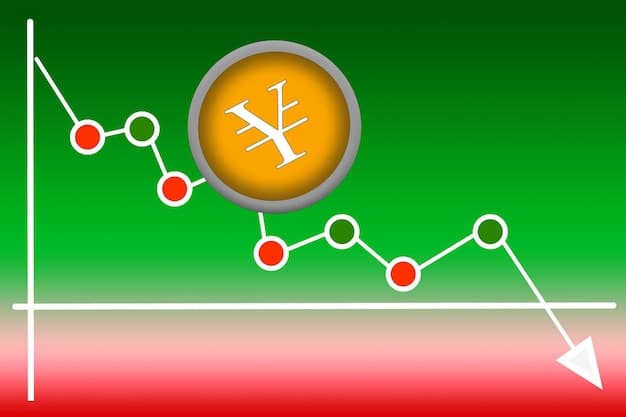Maximize Your Passive Income: Understanding and Utilizing DRIPs

Discover how Dividend Reinvestment Plans (DRIPs) can help you maximize your passive income by automatically reinvesting dividends to purchase more shares, fostering long-term growth and compounding returns.
Looking for a way to grow your investments without constant monitoring? Maximize Your Passive Income: Understanding and Utilizing DRIPs (Dividend Reinvestment Plans) can be an excellent strategy. DRIPs allow you to reinvest your dividends automatically, purchasing additional shares of the company and potentially leading to significant long-term growth.
What are Dividend Reinvestment Plans (DRIPs)?
Dividend Reinvestment Plans, or DRIPs, offer a streamlined method for investors to reinvest their dividends directly back into the company’s stock. This approach allows for compounding returns and incremental ownership without the need for manual transactions.
Understanding the basics is crucial before diving into the mechanics and benefits of DRIPs. They’re not just for seasoned investors; beginners can also leverage them to start building a passive income stream.
The Core Mechanics of DRIPs
DRIPs function by using the dividends you receive from owning shares of a company to purchase more shares of that same company. Usually, these shares are purchased at market value, though some plans offer them at a slight discount.
The process is usually automatic, handled by the company or a transfer agent, eliminating the need for you to manually buy shares each time you receive a dividend.
- Automatic Reinvestment: Dividends are automatically used to purchase more shares.
- Fractional Shares: DRIPs may allow the purchase of fractional shares, meaning every penny of your dividend is reinvested.
- Discount Availability: Some DRIPs offer shares at a discounted price, enhancing your return.
In essence, DRIPs are a simple yet powerful tool for passive investing, especially beneficial in the long term, potentially growing your portfolio more quickly than solely relying on dividend payouts.
Benefits of Utilizing DRIPs for Passive Income
DRIPs offer a myriad of advantages that make them an attractive tool for investors looking to amplify their passive income. They provide a way to continuously invest without incurring additional brokerage fees, fostering long-term growth.
Let’s dive into some key benefits that can make DRIPs an ideal component of your investment strategy.

Compounding Returns Over Time
One of the most significant benefits of DRIPs is the power of compounding. Compounding occurs when the money you earn from your investments (in this case, dividends) is reinvested to generate even more earnings.
Over time, this exponential growth can significantly increase the value of your investment. Each dividend reinvested buys more shares, which in turn produce more dividends, creating a snowball effect.
Cost-Effectiveness and Fee Reduction
DRIPs can be incredibly cost-effective compared to traditional methods of buying stocks. Many companies offer DRIPs that don’t charge brokerage fees for reinvesting dividends, which reduces transaction costs, allowing you to invest more of your money.
This is particularly beneficial for those who want to invest small amounts regularly, as the absence of fees ensures that virtually all your dividends are put to work.
- No Brokerage Fees: Eliminates transaction costs.
- Full Dividend Utilization: Every penny is reinvested, maximizing purchase power.
- Potential Discounts: Some DRIPs offer shares at a discounted rate.
By compounding and reducing costs, DRIPs can provide a significant boost to your investment returns over the long haul, making them a valuable tool for passive income generation.
Setting Up a Dividend Reinvestment Plan
Setting up a DRIP is a straightforward process, though there are a few ways to go about it depending on the company and your existing brokerage accounts. You might go directly through the company or utilize your existing brokerage account.
Understanding these different routes can help you choose the option that best suits your investment style and convenience.
Direct Enrollment Through the Company
Many companies offer direct DRIP enrollment, allowing you to bypass a traditional brokerage account by purchasing shares directly from the company or their transfer agent.
This often requires an initial investment to become a shareholder of record, after which you can enroll in the DRIP. The steps usually involve filling out an enrollment form and providing payment information.
Enrolling Through a Brokerage Account
Alternatively, you can enroll in a DRIP through a full-service or discount brokerage account. Many brokers offer DRIP services on eligible stocks, allowing you to manage all your investments, including DRIPs, in one place.
This method typically involves logging into your brokerage account, navigating to the DRIP enrollment section, and selecting the stocks for which you want to reinvest dividends.
- Brokerage Convenience: Manage DRIPs alongside other investments in one account.
- Direct Enrollment: Purchase shares directly from the company, sometimes with lower fees.
- Eligibility Check: Ensure your stock qualifies for a DRIP through your broker.
Ultimately, setting up a DRIP is an uncomplicated process, but it’s imperative to understand the available options and select the route that aligns with your investing preferences and existing accounts.
Choosing the Right Stocks for DRIPs
Selecting the right stocks is a pivotal aspect of maximizing the benefits of a DRIP. The success of a DRIP strategy hinges on choosing stable, dividend-paying companies with a track record of consistent growth.
Here are a few elements to bear in mind when evaluating stocks for DRIPs.
Evaluating Dividend History and Stability
A key factor to consider is the company’s dividend history. Look for companies with a long-standing record of paying dividends and, preferably, increasing them over time. This is a strong indicator of financial strength and commitment to returning value to shareholders.
Check dividend payout ratios to ensure that the company is not paying out more than it can afford, which could lead to dividend cuts in the future.

Analyzing Company Growth Potential
While dividends are important, the long-term growth potential of the company is equally crucial. A company that is growing and expanding its business is more likely to continue paying and increasing dividends over time.
Assess the company’s industry position, competitive landscape, and growth strategies to gain insights into its future prospects. Growth can fuel further dividend increases and overall appreciation.
- Dividend Consistency: Prioritize companies with a solid dividend history.
- Growth Prospects: Analyze the company’s potential for future success.
- Industry Leadership: Consider companies that are leaders in stable sectors.
In conclusion, selecting the right stocks for DRIPs involves a careful balancing act between dividend reliability and growth potential. Successful DRIP investing combines both to maximize long-term returns.
Tax Implications of Dividend Reinvestment Plans
Understanding the tax implications associated with DRIPs is crucial for effective financial planning. While DRIPs offer seamless dividend reinvestment, they are not exempt from taxation.
Investors need to be aware of how these reinvested dividends are treated for tax purposes to accurately report their income and avoid penalties.
Understanding Dividend Taxation
In the United States, dividends are generally taxed as either ordinary income or qualified dividends, depending on the holding period and other factors. Qualified dividends are usually taxed at a lower rate than ordinary income.
Even though you’re reinvesting the dividends rather than receiving them as cash, they are still considered taxable income in the year they are reinvested. You’ll receive a 1099-DIV form from your broker or the company, detailing the amount of dividends you received.
Cost Basis Adjustments
When you reinvest dividends to purchase additional shares, you need to adjust your cost basis for those shares. The cost basis is the original value of an asset for tax purposes, and it’s used to determine your capital gain or loss when you sell the asset.
Each time you reinvest dividends, you’re essentially buying new shares at a certain price, and this purchase price becomes your cost basis for those shares.
- Taxable Income: Reinvested dividends are taxed in the year they are reinvested.
- 1099-DIV Form: Track taxable dividend income using the 1099-DIV form.
- Cost Basis: Accurately track the cost basis of reinvested shares.
When investing through DRIPs, it’s important to keep detailed records of all dividend reinvestments and their respective cost bases to ensure accurate tax reporting.
Potential Risks and Considerations of DRIPs
While DRIPs present numerous benefits for passive income investors, it is vital to be cognizant of the potential risks and considerations before committing to this investment strategy. Diversification and liquidity concerns are important factors.
Understanding these elements will enable you to make well-informed decisions about whether DRIPs align with your financial goals and risk tolerance.
Lack of Diversification
One of the key risks of DRIPs is the potential lack of diversification. If you’re only reinvesting dividends into a single company, your portfolio may become overly concentrated in that one stock.
This lack of diversification can amplify your risk if the company encounters financial difficulties or if the industry experiences a downturn. It’s crucial to ensure your overall portfolio remains balanced.
Liquidity Concerns
DRIPs can sometimes pose liquidity challenges, particularly if you need to access your funds quickly. Selling shares acquired through a direct DRIP may take longer and involve more steps than selling shares held in a brokerage account.
Ensure that you have other liquid assets available to meet your immediate financial needs, rather than relying solely on DRIP investments.
- Diversification Awareness: Avoid over-concentration in a single stock.
- Liquidity Planning: Consider the ease with which you can access your funds.
- Company Health: Continuously monitor the financial health of the companies.
Being cognizant of these risks and considerations allows you to strategically incorporate DRIPs into your portfolio in a balanced manner, mitigating their potential downsides while capitalizing on their passive income benefits.
| Key Point | Brief Description |
|---|---|
| 💰 DRIP Basics | Reinvest dividends to buy more shares automatically. |
| 📈 Compounding | Reinvesting dividends leads to exponential growth over time. |
| 💸 Cost Savings | DRIPs often have reduced or no brokerage fees. |
| ⚠️ Diversification | Avoid over-concentration in a single stock by diversifying. |
Frequently Asked Questions
▼
The minimum investment varies by company. Some require owning only one share, while others have higher initial investment thresholds. Check with the specific company’s DRIP program for details.
▼
Yes, DRIPs are suitable for beginners. They provide a straightforward way to invest passively, benefitting from compounding. However, understanding the underlying stock is essential.
▼
Reinvested dividends are still taxable in the year they’re reinvested, just as if you received them in cash. You’ll receive a 1099-DIV form detailing the amount.
▼
Selling shares may take longer than selling shares in a brokerage account. Direct DRIPs might require additional paperwork. Plan accordingly for liquidity needs.
▼
If a company stops paying dividends, the DRIP is discontinued. This highlights the need to analyze dividend history and company stability before investing in a DRIP.
Conclusion
Incorporating Dividend Reinvestment Plans (DRIPs) into your investment strategy can be a potent pathway to amplifying passive income and fostering long-term financial growth. By reinvesting dividends automatically and capitalizing on compounding returns, DRIPs offer a seamless way to increase your portfolio’s value. Although it is important to understand potential risks such as lack of diversification and tax implications, starting a DRIP strategy could be the right decision to help you reach your financial goals.





